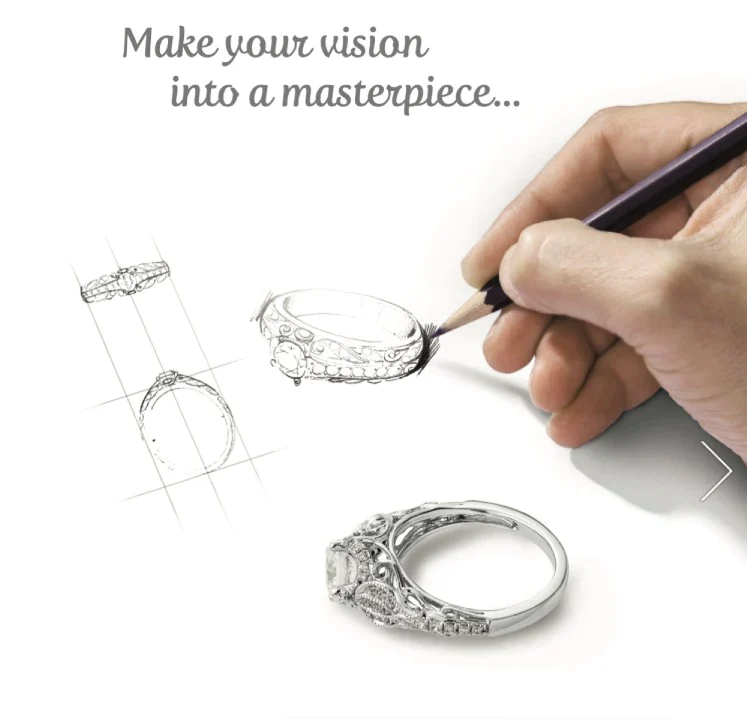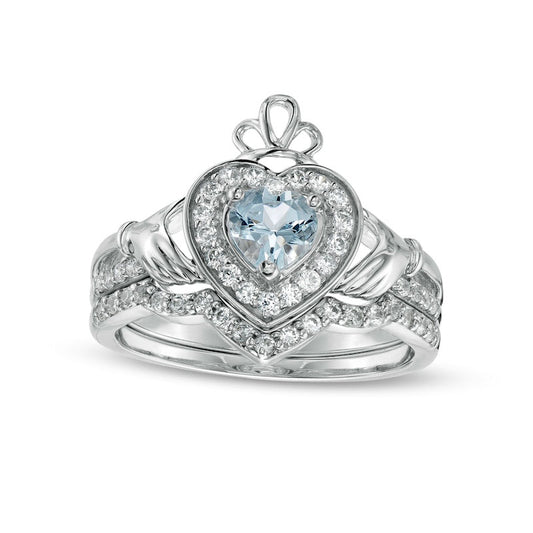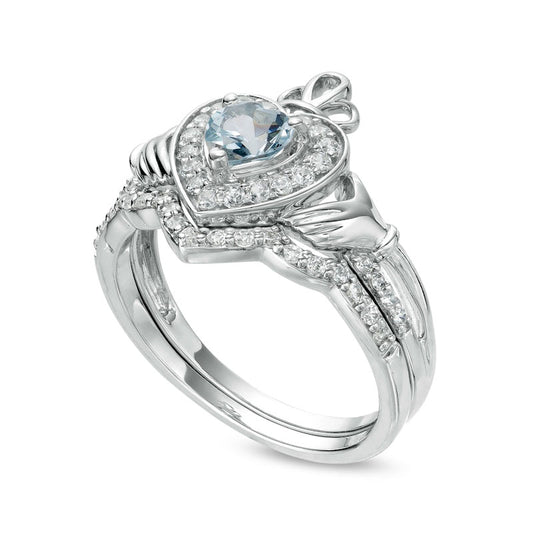-
5.0mm Heart-Shaped Aquamarine and 0.33 CT. T.W. Natural Diamond Frame Claddagh Bridal Engagement Ring Set in Sterling Silver
Regular price $652.99 USDRegular priceUnit price per -
6.0mm Aquamarine and 1/4 CT. T.W. Diamond Frame Bridal Engagement Ring Set in 14K White Gold
Regular price $684.99 USDRegular priceUnit price per$1,414.00 USDSale price $684.99 USDSale -
Pure Serenity 14k White Gold 1/3 Ct. Lab Grown Diamond VS/SI and Oval Lab Created Aquamarine Halo Engagement Ring
Regular price $515.99 USDRegular priceUnit price per$1,290.00 USDSale price $515.99 USDSale -
Marquise Aquamarine and 0.20 CT. T.W. Natural Diamond Bridal Engagement Ring Set in Solid 10K Rose Gold
Regular price $520.99 USDRegular priceUnit price per -
7.0mm Cushion-Cut Aquamarine and 0.33 CT. T.W. Natural Diamond Frame Three Stone Bridal Engagement Ring Set in Solid 14K White Gold
Regular price $1,688.06 USDRegular priceUnit price per -
7.0mm Aquamarine and 0.38 CT. T.W. Natural Diamond Frame Bridal Engagement Ring Set in Solid 14K White Gold
Regular price $1,688.06 USDRegular priceUnit price per -
Pear-Shaped Aquamarine and 0.38 CT. T.W. Natural Diamond Frame Twist Shank Bridal Engagement Ring Set in Solid 14K White Gold
Regular price $1,688.06 USDRegular priceUnit price per -
7.0mm Aquamarine and 0.38 CT. T.W. Natural Diamond Bypass Leaf Shank Bridal Engagement Ring Set in Solid 10K White Gold
Regular price $1,363.67 USDRegular priceUnit price per -
Oval Aquamarine and 0.10 CT. T.W. Natural Diamond Bypass Split Shank Bridal Engagement Ring Set in Sterling Silver
Regular price $932.99 USDRegular priceUnit price per -
8.0mm Aquamarine and 0.33 CT. T.W. Natural Diamond Frame Bridal Engagement Ring Set in Solid 14K White Gold
Regular price $1,817.86 USDRegular priceUnit price per -
8.0mm Aquamarine and 0.25 CT. T.W. Natural Diamond Frame Engagement Ring in Solid 14K White Gold
Regular price $1,000.99 USDRegular priceUnit price per -
6.0mm Aquamarine and 0.17 CT. T.W. Natural Diamond Infinity Shank Bridal Engagement Ring Set in Solid 10K White Gold
Regular price $886.99 USDRegular priceUnit price per -
7.0mm Cushion-Cut Aquamarine and 0.38 CT. T.W. Natural Diamond Frame Engagement Ring in Solid 14K White Gold
Regular price $1,363.67 USDRegular priceUnit price per -
6.5mm Aquamarine and 0.25 CT. T.W. Natural Diamond Antique Vintage-Style Bridal Engagement Ring Set in Solid 10K White Gold
Regular price $1,045.66 USDRegular priceUnit price per -
Oval Aquamarine and 0.20 CT. T.W. Natural Diamond Frame Antique Vintage-Style Bridal Engagement Ring Set in Solid 10K White Gold
Regular price $979.99 USDRegular priceUnit price per -
6.0mm Cushion-Cut Aquamarine and 0.20 CT. T.W. Natural Diamond Frame Art Deco Bridal Engagement Ring Set in Solid 10K White Gold
Regular price $1,026.19 USDRegular priceUnit price per

Are the Products Above not Really What You are Searching for?
Let us help make your dream jewelry a reality! Use our easy three part Get-A-Quote form to begin the magic of creating your own, custom designed jewelry. Fill in your Contact Information, Jewelry Information, Upload Images, and add any Notes - click Submit, and one of our design team reps will be in touch within 12-24 hours.
Aquamarine and Diamond Engagement Rings
There may come a time when you make that important decision to spend the rest of your life with that special someone. Of course, you would need a ring when the time comes! A stunning ring that reflects the personality of your partner, a ring that says “I love you deeply”.
Lucky for you, there are so many choices when it comes to engagement rings. An all-time favorite is the aquamarine and diamond ring.
Before we dive into the world of diamonds and aquamarine, a little trip down history is due.
History Of Engagement Rings
The art of giving engagement rings is found in history books and archeological findings dating back over 2000 years ago. Over the centuries, the appearance and customs surrounding engagement rings have evolved. However, their purpose which is uniting two people in love has remained unchanged.
According to history, Egyptians and Greeks exchanged rings in their betrothal ceremonies making them the starters of the lifelong tradition of engagement rings.
The Roman Empire and the Visigoth Kingdom give the earliest clear evidence of the practice.
Roman engagement rings were usually two. The women of the lower and middle class received a ring made of iron and the other of gold. She would wear the iron while working at home; the gold when she went out into the society.
The women to be married to affluent men usually government officials received more elegant rings. The rings typically had a larger band and were engraved with ivory or small unpolished stones.
When the Visigoth Kingdom seized power. The engagement rings saw advancements in their settings. The women’s rings had much more elaborate settings, some of which resemble today’s cathedral setting.
A little further in time and the engagement rings set with diamonds were introduced. The Archduke of Austria, Maximilian the 1st, proposed to his betrothed, Mary of Burgundy with a diamond engagement ring. This ring changed the life of the woman and engagement rings as they were known.
In the Victorian era, other colored gemstones were brought into the picture. The engagement rings featured the diamond, and other gemstones like aquamarine, sapphire, rubies, etc.
However, in the 1930s the diamond engagement rings saw a massive decline in demand. This was due to the harsh economic situation; and the fact that men had been charging out to war made couples settle for simple wedding bands alone.
A major leading jewelry company at the time, De Beers, saw the imminent collapse of the jewelry industry. This made them come up with the slogan, “A diamond is forever” for their advertisements. Those four words certainly did the magic. In a few years, the sale of diamonds had doubled in the USA alone.
This classic slogan of the De Beers company relates to marriage being forever. It highly increased the romantic appeal of diamonds.
Today, diamonds are highly sought after gems for an engagement ring. Various twists to using the gem have also surfaced such as pairing it with other beautiful gemstones.
Aquamarine
It is a gemstone that ranges from light pastel to deeper hues of blue. It may have a greenish tinge to it. It belongs to the Beryl family alongside Morganite and emerald.
This semi-precious gemstone is durable and easy to work with. This makes it the perfect gem to pair with a diamond on your engagement ring as it can be cut into various shapes. It ranges from 7.5 to 8 on Moh’s scale of hardness, this makes it less likely to scratch.
Meanings Attached To Aquamarine
The gem’s name originates from two words, aqua marina, meaning “seawater.” This is because of the gem stone's beautiful color which resembles the sea.
In ancient times, it was believed that aquamarine bestowed luck and safe travels among sailors. The gem also served as a talisman against negative experiences and was believed to cure poisoning sometime in the middle ages.
In the modern-day though, the gem can be attributed to tranquility transparency, and calm. As a symbol of marriage, aquamarine is believed to reflect union, trust, fidelity, and harmony. It also gives off feelings of clarity and purification.
Getting an aquamarine engagement ring is a very good idea for a person that has a connection with the sea. It certainly can’t get more personal and romantic than that!
Meanings Attached To Diamonds
For most couples, a diamond engagement ring is at the top of their list. Aside from the beauty and sparkle of the gem, what diamonds represent is quite significant.
Diamonds are the hardest substance on earth, they score a 10 on Moh’s scale of hardness. A diamond will be used in an engagement ring because of this. Your love should be forever, in the same way, according to De Beers’ classic saying “A diamond is forever.”
Diamonds are the embodiment of marriage and love.
Aquamarine And Diamond Rings
Combining gemstones in rings is a trend that has stood the test of time. The aquamarine and diamond combo is more than just another gemstone combination.
The tranquility and calmness of the beautiful blue hues in aquamarine make a striking blend with the long-lasting, strong colorless to slightly colored diamonds.
Light blue aquamarine is more common than the darker varieties. This makes the latter more expensive. So, if you’re on a budget a colorless diamond will pair beautifully with a flawless light aquamarine. And if you’re willing to spend a little more then the colorless diamond will greatly emphasize the beauty of a darker aquamarine. Whichever way you choose to go, you will get value for your money.
It’s one thing to decide on an aquamarine and diamond engagement ring, it’s another to choose the ring style.
Settings For Your Ring
Here are some gorgeous settings that work well with the gems, aquamarine, and diamond.
- Halo Ring Setting: This is a setting featuring a large center gemstone with smaller pavé, micro-pavé diamonds, or colored gemstones surrounding it in a halo. The halo could be double or triple. It could even be hidden.
The halo ring's shank(the part encircling the finger) could be plain, paved, or split.
The center stone is usually a diamond, so having an aquamarine halo will be beautiful. Alternatively, you may switch their places. Make your halo ring feature an aquamarine center stone with a diamond halo.
Not to mention the halo ring is a fashionable choice for an engagement ring. Second only to the classic solitaire.
Here are the pros of a halo ring setting:
▪ The halo offers protection to the center stone. For this reason, it is better to use aquamarine as the center stone due to its relative softness in comparison with diamonds.
▪ It offers a vintage feel.
▪ The halo makes the center gemstone appear up to a half-carat larger.
▪ The surrounding gemstones enhance the ring's overall sparkle.
The disadvantages are:
▪ The small stones in the halo may fall out over time. ▪ Depending on the number of stones surrounding the shank, resizing this ring might be a hassle.
- Channel Ring Setting: The channel setting features diamonds in a row set in the band of the ring. The diamonds or colored gemstones are arranged closely together in the grooves of the band.
In this setting, the aquamarine and diamond can be set side by side. Or either gem could serve as the center stone and the other will make up the channel.
Some pros of this setting are:
▪ The setting offers protection of the stones along with the band and securely holds it in place.
▪ It enhances the sparkle of the gem with its side stones. ▪ Cloth and similar materials are less likely to snag onto the ring.
Some disadvantages are:
▪ The channel setting may hide the diamond or aquamarine slightly more than a prong setting.
▪ Because of the nature of this setting, it is difficult to clean the ring.
▪ Resizing can be challenging, especially if the side stones encircle the entire band.
- Three-Stone Setting: As the name implies, a ring with this set comprises three stones. The gemstone represents a couple’s past, present, and future.
The three stones may be the same size. However, it is more common in the three-stone setting for the center diamond to be larger than the two side stones.
A mix of gemstones works beautifully in this setting. Typically, the side stones are the same and the center stone is different. Your aquamarine and diamond engagement ring will look stunning in this setting.
Here are the pros of choosing this ring setting:
▪ It enhances the sparkle and brilliance of the gemstones ▪ It allows the personalization and contrast of colors. ▪ The three-stone setting enables the presence of multiple large stones.
▪ It achieves a great surface area as opposed to a single gemstone.
Now, the cons of this stunning ring setting:
▪ When the gemstones are paired poorly, the center stone can be overpowered by the side stones.
▪ Requires a lot of cleaning and maintenance; much more than a single gemstone ring.
- Split Shank Ring Setting: The shank is the part of the ring that encircles the finger. A split shank divides as it meets the center stone. The shank is typically paved, although it can be left plain.
A shank is usually round but it can be square-shaped or in other creative shapes.
Here are the benefits of picking a split shank for your engagement ring:
▪ It can be made into a vintage or modern design.
▪ A paved shank boosts the ring’s overall brilliance.
▪ The split in the shank leads the eye to the center gem; this gives it maximum attention.
The cons of a split shank engagement ring are:
▪ The cleaning process may be a bit more tedious.
▪ Due to being less streamlined, the ring is not suited for people who do active work with their hands.
- Eternity band: Technically, the eternity band is not a ring setting. But it does feature gemstones all around the band; they could be diamond or other colored gemstones.
It will serve as a beautiful shank in your aquamarine and diamond engagement ring. It works well with halo, bezel, channel settings, etc.
The eternity band has a variety of uses. It serves as a decent anniversary band, birthday, or any special occasion gift.
The pros of this band are:
▪ The never-ending gemstones represent the never-ending love of two people. This makes it the perfect engagement ring. ▪ It pairs well with other rings such as the wedding or anniversary band.
▪ It brings that extra sparkle as the gems encircle the entire finger.
▪ It holds the smaller diamonds securely.
▪ It adds elegance to the ordinary metal or plain band style. The downsides of the eternity are:
▪ Resizing the rings is nearly impossible because the gemstones surround the entire band.
▪ To maintain sparkle requires routine cleaning of the crevices and stones.
The above are just some beautiful settings for your engagement ring. There is always room to make your little twist on these rings. Make sure to inquire from a trusted jeweler about how well these work.
Factors To Consider When Purchasing An Aquamarine And Diamond Ring
Like you would for many other gems, pay attention to the 4 C's when selecting them.
- Cut: An aquamarine can be cut into a variety of shapes like diamonds. Being softer than diamonds, it is easier to facet them into many beautiful shapes.
You can shape your gems into cuts like cushion cut, round cut, princess cut, oval cut, emerald cut, etc.
The way the diamond is faceted determines how much white light it will emit to produce sparkle and brilliance. Although an aquamarine doesn’t reflect much brilliance, it can be faceted in a step cut to maximize the little sparkle it can give off.
- Clarity: Aquamarine is usually found in a flawless to near flawless state. This makes it easier for jewelers to shape it to appear eye-clean.
Diamonds are graded with “flawless” being the top grade and “included” at the bottom of the scale. In increasing order, VS1-2 to
F are grades that appear eye clean and are a good choice for your engagement ring.
- Carat: Another major thing to consider is the carat weight of the gem. Generally, higher carat gemstones will cost more than a lower carat.
The good news about this is that a higher carat doesn’t always mean better quality. If you are on a budget, you can get a high quality low carat aquamarine or diamond.
- Color: When selecting an aquamarine, it is especially important to pay attention to the colors. A light blue aquamarine is relatively cheaper than a dark blue variety. This is because the darker hues of aquamarine are rarer.
An aquamarine gem will have a few greenish tinges as well. The gem may be treated at high temperatures to remove these green hues. This type of treatment is accepted but your jeweler should inform you of any treatments the gemstone has undergone.
You will need to examine your gem properly when you’re buying it, this is because aquamarine looks very similar to the gem, topaz. Some dishonest jewelers may try to pass it as aquamarine.
Colorless diamonds are extremely rare. The diamonds that you will easily find may appear colorless but in actuality, they may have slight, almost invisible yellow or brown tinges. The diamond color scale ranges from “D” being colorless to “Z” being quite yellow or brown.
A diamond beyond “Z” is referred to as a fancy diamond. This makes the diamond even more expensive.
Whatever color, cut, carat weight, and clarity level you decide on will work elegantly as an engagement ring.
Maintaining Your Aquamarine And Diamond Engagement Ring
Cleaning Your Ring
You will need to take your ring to the jeweler for a proper and thorough inspection once every year.
However, you can clean these gems at home. Since an engagement ring is meant for everyday wear, it is bound to pick up specks of dirt.
To keep your gemstones looking stunning, clean them with a soft brush over warm water and mild detergent. Make sure to rinse them under running water when they come clean.
In the same way, clean the band of the ring. It’s no use having a sparkling gem with a dirty setting.
Proper Storage Of Your Aquamarine And Diamond Ring
Wrap your ring in a soft cloth, or its box, and store it separately from other jewelry. This will prevent one jewelry piece from scratching the other.
In conclusion, a diamond with a colored gemstone such as aquamarine makes for an elegant combination in an engagement ring. If you would like to behind your search for the right one for you, click here.



































